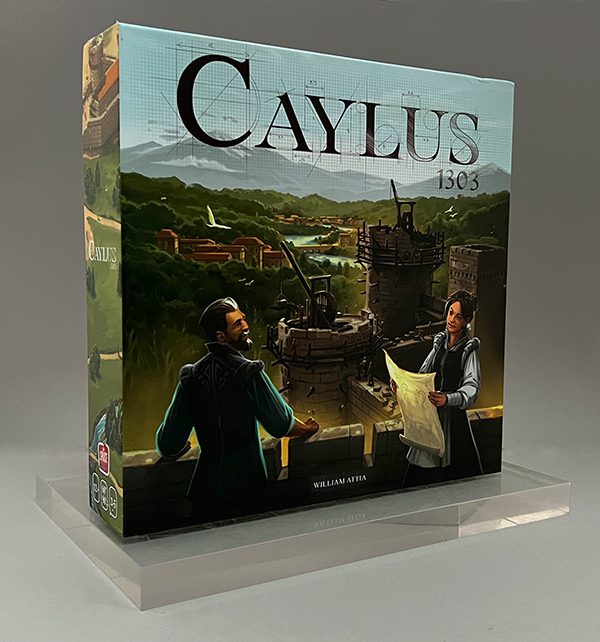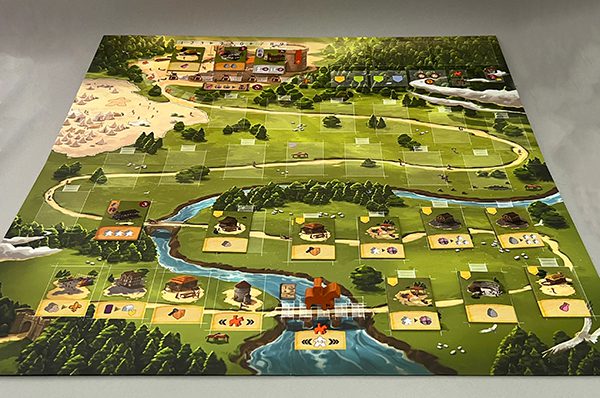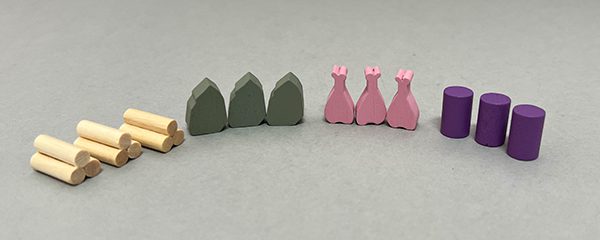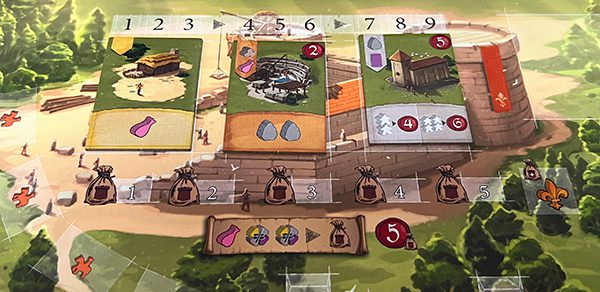Disclosure: Meeple Mountain received a free copy of this product in exchange for an honest, unbiased review. This review is not intended to be an endorsement.

The castle of Caylus is in need of serious renovations, and you and your fellow Builders are just the people for the job. Over the course of nine rounds, you will send materials to the castle to aid in this effort. You’ll also be adding buildings to the surrounding town, buildings that will further support both the castle and your goal of achieving the most Prestige by the end of the game.
The Long and Winding Road
Caylus 1303 starts on a twisting road, the one just past Guilds Bridge, and ends at the Caylus castle gates. The eight spaces along that road, from bridge to next bridge, are populated by a series of initial, randomly set out, buildings. Here, you and your fellow Builders will place your Workers, claiming the resource offered or trading resources for different resources. You might even trade resources to build another building along the road.

You’ll start the game with a set number of Workers, a number that varies depending on player count. Placing Workers is simple: you just place one worker on a building, first come, first served. Then, at some point, one of you will decide to stop placing Workers. Not only does this grant that person the First Player token for the next round, but it also immediately increases the number of Workers all other players must use to claim a building by two: one to be placed on the building and one to retire to the Worker’s Camp.
That Worker’s Camp sits off to the side of the castle and, with its dust and tents, looks rather unimpressive. That, of course, belies the importance of the Workers there. You may start the game with, say, six Workers, but at the start of each round, you’re only going to be able to convince three of your fifteen workers to come back to your supply.
At the end of each round, you and your fellow Builders will travel along that winding road, resolving each building’s actions in order, as you encounter them.
To put a possible hitch in your plans is the Provost. The Provost’s job is to survey the town to make sure each new building will please the King. At the start of each round, the Provost is placed behind the last building built—and only buildings behind the Provost will activate that round.
Players have the ability to, well, bribe the Provost at the end of their turn. As part of your decision to stop placing Workers at the end of each round, you can also choose to use other Workers in your active reserve to move the Provost forward or even backward along the road. Say the Provost is sitting just in front of a building one of your opponents is counting on activating. You could spend an extra worker to move the Provost back one space so it doesn’t activate.
That Leads to Your Door
As a worker placement game where you’re collecting and managing resources, it’s important to remember that this is really a game about having the most Prestige (victory points) at the end of nine rounds.

Acquiring Prestige can be done by either building new buildings or making offerings to the castle. Each new building will grant you a certain amount of Prestige, while aiding in the construction of the castle does that and a bit more.
To help out with the castle, you’ll need to place a Worker on one of the Construction Site spaces at the end of the road. Building this castle requires you to surrender three different resources, with one of those resources always being food. After your one food, you can give the castle two different resources of your choosing.

Aiding with the construction of the castle will earn you 5 Prestige. You can earn 5 more Prestige if you were the first player to place a worker there or if you make the most offerings that round.
Along with Prestige, a successful donation to the castle will also allow you to either:
- Take the action listed on one of the buildings set aside for castle use and take an unclaimed Character or
- Steal a Character from another player
Will Never Likely Disappear
There is a current trend in gaming where rules seem to be set within the game just so that they can be broken. There are a great many asymmetrical games that use this mechanism, while only a few offer truly unique powers. The Characters in Caylus 1303 perform a combination of these options.
At the start of each game, a random selection of Characters will be chosen equal to player count +3. Each player will receive a Character and the remaining three are placed to the right of the castle.
Characters allow you to do things like move the Provost one space for free; gain additional Prestige for each offering made to the castle; earn extra Prestige for each building you construct; or place one of your Workers at the start of a round, even before the first player places a Worker.

Your Character’s attribute is likely to attract the attention of the other players around the board, just as their Characters’ abilities will catch your notice. As if Prestige wasn’t incentive enough to send a Worker to the Construction Site, gaining or stealing Characters makes doing so even better.
In the earliest rounds, those three extra Characters will be just waiting to be claimed. After taking a Building action at the castle, you can take whichever Character you’d like. Then again, you could just skip that Building action and claim a Character from an opponent.
Those Character abilities can easily change the course of a game. As a result, it’s no surprise that I’ve seen rounds where one player has 4+ Characters at the end of their turn—only to have most of those Characters stolen away by the end of the round.
I’ve Seen That Road Before
Back in 2005, William Attia released the original Caylus. It was one of the earliest worker placement games, a game mechanic that would explode over the following decades. (BoardGameGeek now lists over 3000 worker placement games.) It’s a favorite of my colleague David McMillan, although it has enough viscous take-that elements to make it a potentially difficult game to play with your significant other.
Caylus has retained a dedicated following over the years, which is a clear testament to the original design and mechanics. There are some who still aren’t convinced the game needed to be redesigned. In an interview, Attia acknowledged it took him a few years to become convinced of the idea, too.
I have not played the first Caylus, so I can’t speak to how the updates have changed the way Caylus 1303 plays compared to the original. I can say, however, in that same interview, Attia said it was important to him that the fidelity of the original carried through to the new version of the game. So, while the heart of the game has remained, the changes made were meant to streamline the experience to fit a more modern audience. This means the new game remains true to Attia’s vision while becoming somewhat shorter than the original, and more accessible to new players.
For instance, in Caylus, there was a monetary cost associated with placing a Worker. In Caylus 1303, that ‘cost’ only comes into play after one player has passed. The large Favors table that dominated the upper right corner of the original board has been simplified to become the Characters mentioned earlier.
Oh, in case you were wondering why it’s called Caylus 1303 and not Caylus Second Edition? The original Caylus was set in 1289. The new game was released 14 years later, and 1289 + 14 = (Caylus) 1303.
It Always Leads Me Here, Leads Me to Your Door
Years ago, a former regular gaming friend of mine told the group, “If a game doesn’t have Meeples, Tom doesn’t like it.”
While not entirely true (personally, I’d roughly divide my collection into Worker Placements, Abstracts, and Others), I do acknowledge a strong preference for worker placement games.
I approached Caylus 1303 with some hesitation. I never bought the original because it seemed overly fussy and complicated. However, the idea of a more streamlined version raised different concerns. Was this going to be overly simplified? Too easy?
I need not have been apprehensive. Caylus 1303 is a fantastic game. Fantastic.
Having played lots of worker placement games, the teach on this was simple. We all recognized mechanics the original Caylus had inspired in other games, meaning my group was ready to play Caylus 1303 faster than any other game in recent memory.
And yet, Caylus 1303 needs to be played several times before you truly appreciate just how well designed it is. Remember those initial Buildings set up after Guild Bridge? They’re randomly set out at the start of each game. In our first game, we had lots of resources available in those first buildings. This meant we could end a round by collecting resources and then trading them in for better resources. In our second game, most of those basic resources were at the end of that stretch of road. This meant our first round was spent collecting resources we could only send to the castle and/or save for the next round to construct other Buildings.
Did I mention the game plays out over only nine rounds? Yeah, nine rounds. In that second game, we all acknowledged that it felt like we only had eight rounds to play it in—something that only made our choices that game even more interesting.
Throughout this brief game you’ll be struggling to gain Prestige. One key strategy is sending goods to the castle each round. (This guarantees at least 45 Prestige: 5 Prestige x 9 Rounds) But you’ll be limited in your ability to do so unless you add Buildings to the road to provide additional resources—resources that include the additional Workers you’re also going to need along the way. Thankfully, not only will you score Prestige for constructing them, but you’ll also earn Prestige any time another player uses that Building.
Caylus 1303 creates a very tight inter-dependent economy, one that is both similar yet disparate in each game. It’s no exaggeration that every time I’ve played it, the game has felt different. The choices, and therefore the decisions and their subsequent ramifications, all meander differently along this long and winding road.
If you’re a fan of worker placement games, or even if you’ve never played one but wondered which game to start with, I definitely encourage you to give Caylus 1303 a try.












Add Comment